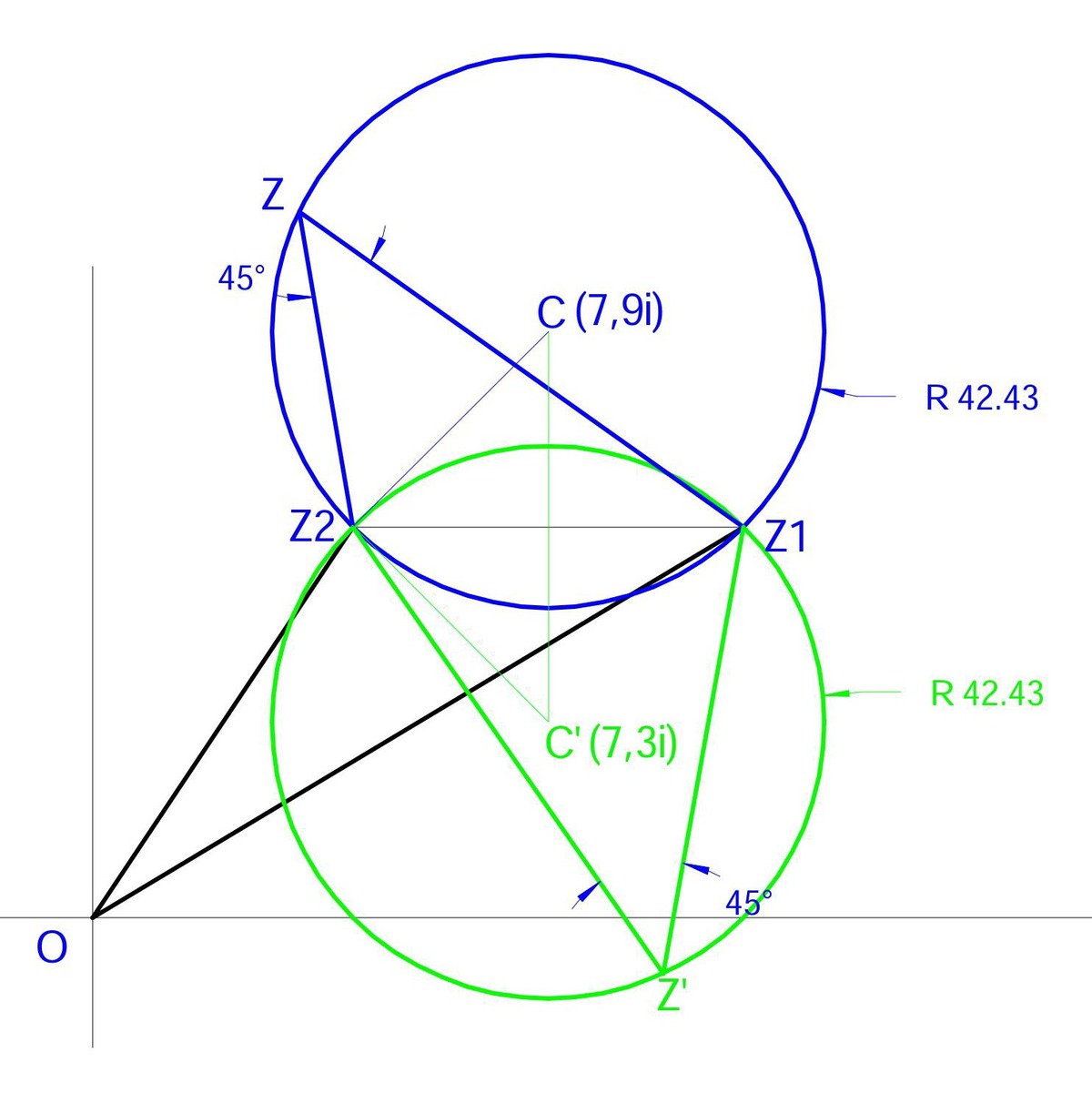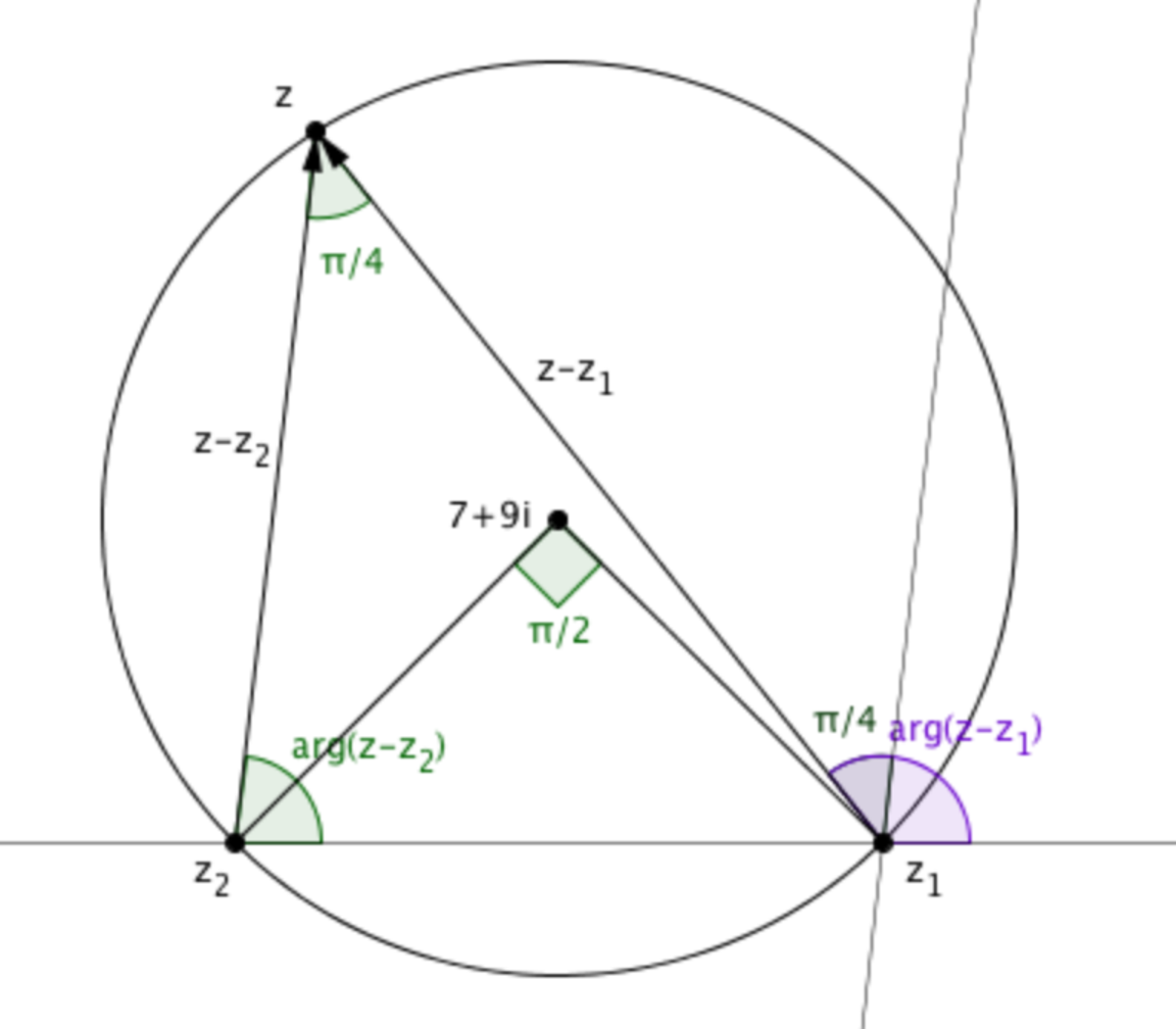Solve it like a Mathematician.
Let z 1 = 1 0 + 6 i and z 2 = 4 + 6 i . If z be a complex number such that arg ( z − z 2 z − z 1 ) = 4 π , then find the value of ∣ z − 7 − 9 i ∣ . Give your answer up to 3 decimal places.
If you're looking to skyrocket your preparation for JEE-2015, then go for solving this set of questions .
The answer is 4.243.
This section requires Javascript.
You are seeing this because something didn't load right. We suggest you, (a) try
refreshing the page, (b) enabling javascript if it is disabled on your browser and,
finally, (c)
loading the
non-javascript version of this page
. We're sorry about the hassle.
7 solutions
Good solution. I was trying to get what you have got.
Exactly ! I also use "JEE style " . Convert it into Equilateral /right angled isosceles triangle is Best way to do such problems :)
Let z = a + b i then, we have:
z − z 2 z − z 1 = ( a − 4 ) + ( b − 6 ) i ( a − 1 0 ) + ( b − 6 ) i = ( a − 4 ) 2 + ( b − 6 ) 2 [ ( a − 1 0 ) + ( b − 6 ) i ] [ ( a − 4 ) − ( b − 6 ) i ] = ( a − 4 ) 2 + ( b − 6 ) 2 ( a − 1 0 ) ( a − 4 ) + ( b − 6 ) 2 + ( b − 6 ) ( a − 4 − a + 1 0 ) i = ( a − 4 ) 2 + ( b − 6 ) 2 a 2 + b 2 − 1 4 a − 1 2 b + 7 6 + ( 6 b − 3 6 ) i
Since ar g ( z − z 2 z − z 1 ) = 4 π ⇒ a 2 + b 2 − 1 4 a − 1 2 b + 7 6 6 b − 3 6 = 1
⇒ 6 b − 3 6 = a 2 + b 2 − 1 4 a − 1 2 b + 7 6 ⇒ a 2 + b 2 − 1 4 a − 1 8 b = − 1 1 2
Now,
∣ z − 7 − 9 i ∣ = ( a − 7 ) 2 + ( b − 9 ) 2 = a 2 + b 2 − 1 4 a − 1 8 b + 4 9 + 8 1 = − 1 1 2 + 4 9 + 8 1 = 1 8 = 4 . 2 4 3
exactly what i did!!!
forgot to take sqrt!
this is what i followed
I did same.
Yesterday, I studied complex numbers, now I am solving problems.
Brute force method. Not going by the way of the Title of the Problem
Check yhe solution in image
did it the same way!
 Being the argument of division of the two complex pi/4, means that z must be in circumference which center is or 7➕9i or 7➖3i, passing over z1 and z2, since from z you see that point z1 and z2 form a 45 degree angle. Obviously the radius is Sqrt( 3^2+ 3^2).
Being the argument of division of the two complex pi/4, means that z must be in circumference which center is or 7➕9i or 7➖3i, passing over z1 and z2, since from z you see that point z1 and z2 form a 45 degree angle. Obviously the radius is Sqrt( 3^2+ 3^2).
Cunningly the poster has chosen one of the possible centers only points in which the modulus of the two complex remains constant for any z located in the mentioned circunferences.
As you mentioned, there are two circles whose major segments form the locus of the point mentioned in the problem. So, what would be the maximum value of the mentioned distance if we consider the the other circle?
Log in to reply
The other circle is symmetrical to segment Z2Z1 , so is the same distance. I have made an image which is ready, so you could see the full scenario but unfortunately the in the reply format no image can be upload or I do not know how to do it.
 Same as other solution, with a little more detailed image to see the angles.
Same as other solution, with a little more detailed image to see the angles.
I will describe the locus of the condition given, in a general way that works for almost (if not all) any Möbius transformation. This trick is extremely common and useful in complex geometry, although in this example it seems over-complicated and unnecessary, but it is worth to be mastered.
First let f ( x ) = z − z 2 z − z 1 . By hand or by formula, it is easy to see f − 1 ( x ) = 1 − z ( 1 0 + 6 i ) − ( 4 + 6 i ) z and look at the image of { z : a r g ( z ) = 4 π } under f − 1 .
Since Möbius transformations preserves generalised circles, which are determined uniquely by 3 points, note that 0 , 1 + i , ∞ get mapped to 1 0 + 6 i , 4 + 1 2 i , 4 + 6 i by f − 1 , so the image we are looking for is the circular arc with endpoints 1 0 + 6 i , 4 + 6 i passing though 4 + 1 2 i . The perpendicular bisectors of the first/third points and second/third points are R e ( z ) = 7 , I m ( z ) = 9 respectively, hence the locus is this circular arc described centered at 7 + 9 i with radius 1 8 , which value is 4 . 2 4 3 answering the question.
One may argue the inverse was not necessary to be found, and could just solve f ( z ) = 0 , 1 + i , ∞ easily (especially for 0 and ∞ ), but since I remember the formula for the inverse, that is what I did.
Cast problem into co-ordinate plane. The points are in horizontal line with z 1 ( 1 0 , 6 ) and z 2 ( 4 , 6 ) . Now, the given condition implies that the arrow joining z 1 to z (arrow at latter) on rotation by π / 4 clockwise will point in the same direction as the arrow joining z 2 to z . Since the points are 6 units from each other, obviously z = 4 + 1 2 i satisfies given condition(the points form an isosceles right triangle).
Hence: ∣ z − 7 − 9 i ∣ = ∣ 4 − 7 + 1 2 i − 9 i ∣ = ∣ − 3 + 3 i ∣ = 3 2
Classic JEE style strikes again.
Edit: If one is really well versed in complex geometry, one can see that the locus described by z is a part of a circle. The point 7 + 9 i is the center of circle, and hence, the answer is simply distance of one of the given points from center(radius) as both given points and z lie on circle.